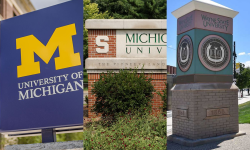Opinion | Michigan public universities can help lead a population revival
For years, demographers have sounded alarms about a declining population in Michigan. The state is projected to have only one-third of the national population growth rate until 2046, when we’ll start contracting, according to a recent report.

Certainly, declining birth rates and migration among states are relevant to the long-term management of the state’s fifteen public universities. Michigan’s public universities are the solution to stopping our slide.
Michigan’s state universities are regional placemaking anchors, drivers of economic growth and, above all else, producers of talented graduates. To remain a viable, competitive state, we’ll need our state universities to help lead Michigan out of the demographic crisis. We won’t retain our youngest talent if we don’t have quality public universities around the state serving as hubs of activity and inquiry.
Fiscal year 2022 was the 11th consecutive year of national enrollment decline in higher education. This is a national crisis with regional exceptions, not just a Michigan problem. Only by investing in our public universities to provide a competitively affordable education will we keep our own young adults in state and continue attracting nonresidents.
Michigan’s three public universities with the highest levels of research are, naturally, economic powerhouses. They enroll almost half of the sector’s 256,000 students each year and, according to the latest data from the University Research Corridor, generated $2.6 billion in research and development spending last year. In the last five years, they produced 241 patents, 698 invention disclosures and 27 start-up businesses.
Students move to Ann Arbor, Detroit, or East Lansing and don’t want to leave – if they can continue researching after graduation or start a business, they won’t have to.
Our state’s regional universities are also major draws for students and alumni. But what’s vital about regional universities is the outsized role they play in supporting their communities and local economies. Economics research shows that the presence of a regional university makes local economies more resilient during bad business cycles, and offsets the local risk from manufacturing sector contractions.
What would have happened to the Upper Peninsula if Northern Michigan University and Lake Superior State University weren’t there when local military bases closed? Or what about Southwest Michigan without Western Michigan University after several major industries left?
Young people, including non-students, want to live near universities for a reason, and Kalamazoo and Marquette are lively these days.
Young people will move not just for a job, but also for culture, fit and politics. The Chronicle of Higher Education has documented for over a year now how political attacks on universities in other states are putting their faculty and potential students on the national market. In a national survey, 25 percent of students ruled out entire states based on political, policy, or legal issues.
While this is true across the political spectrum, the states most frequently ruled out are Alabama, Florida, Louisiana and Texas, and it’s especially true for particularly targeted students. Michigan is fortunate to have a mix of large urban or suburban universities and smaller rural state universities all under a welcoming and autonomous state environment so a student from any background (or state) can pick the institution right for them.
Increasing Michigan’s population doesn’t mean ignoring the needs of our state as it is. The public universities aren’t just focused on 18–21-year-olds, but also provide online and evening classes for working adults. A challenge in growing Michigan’s population is economic insecurity for those without a degree. If a public university can help a 27-year-old finish their degree, then the odds increase that they can afford to raise children.
Further, older residents will simply need more health care. Michigan’s public universities produce thousands of health professionals annually – 10,600 in 2021 alone.
And if graduates do a clinical experience or residency here, they’re more likely to stay here.
Gov. Gretchen Whitmer should be commended for creating the Growing Michigan Together Council. It demonstrates to the rest of the country that our state is serious about growing its population and talent base. It’s my hope that as the administration and legislative leaders finalize budget discussions in the coming days, they remember the vital role the public universities play in securing Michigan’s demographic and economic future.
See what new members are saying about why they donated to Bridge Michigan:
- “In order for this information to be accurate and unbiased it must be underwritten by its readers, not by special interests.” - Larry S.
- “Not many other media sources report on the topics Bridge does.” - Susan B.
- “Your journalism is outstanding and rare these days.” - Mark S.
If you want to ensure the future of nonpartisan, nonprofit Michigan journalism, please become a member today. You, too, will be asked why you donated and maybe we'll feature your quote next time!




